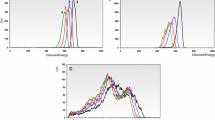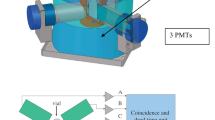Abstract
Background
Tritium (3H) emits low-energy beta particles with a maximum energy of 18.6 keV. Liquid scintillation counting technique (LSC) is mostly used for the detection and quantification of low-energy emitters like H-3. The most widely used method to determine the level of tritium in humans is testing urine.
Method
In this study, tritium activity concentrations in urine samples taken from 20 adults were measured. Their ages range from 23 to 50. Eight of them are female, and others are male. The tritium activity concentrations in urine samples were determined with two different methods. Also, two standard samples were used to compare urine samples.
Result
The efficiency values were found with two different methods (26.07% for the first method and 26.14% for the second method). According to the comparison results, the tritium concentration differences between these methods were found in a negligible level for urine samples and in an acceptable level for standard samples.
Conclusion
The tritium activity concentrations in urine and standard samples were calculated using two different methods. According to the comparison results, these two methods can be used for determination of tritium concentrations in urine samples.
Access this article
We’re sorry, something doesn't seem to be working properly.
Please try refreshing the page. If that doesn't work, please contact support so we can address the problem.

Similar content being viewed by others
References
UNSCEAR, Sources, Effects and Risks of Ionizing Radiation: Report to the General Assembly with Annexes. United Nations Scientific Committee on the Effects of Atomic Radiation, New York (1988)
S. Kaufman, W. Libby, Phys. Rev. 93, 1337–1344 (1954)
S. Okada, N. Momoshima, Health Phys. 65, 595–609 (1993)
M. Puhakainen, T. Heikkinen, Radiat. Prot. Dosim. 128, 254–257 (2008)
R.L. Hill, J.R. Johnson, Health Phys. 65, 628–647 (1993)
ICRP, Protection of the Public in Situations of Prolonged Radiation Exposure. ICRP Publication 82, Ottowa (1999)
A. Pantyaa et al., Appl. Radiat. Isot. 137, 18–22 (2018)
P.L. Goff et al., Environ. Int. 65, 116–126 (2014)
M.J. Wood et al., Health Phys. 65, 610–627 (1993)
G. Rauret et al., Analyst 115, 1097–1101 (1990)
L. Pujol, J.A. Sanchez-Cabeza, Radioanal. Nucl. Chem. 242, 391–398 (1999)
I. Schäfer et al., Appl. Radiat. Isot. 53, 309–315 (2000)
C. Zhilin et al., Appl. Radiat. Isot. 68, 1855–1858 (2010)
J.L. Erchinger et al., Appl. Radiat. Isot. 126, 168–170 (2017)
S. Dizman et al., Isot. Environ. Health Stud. 51, 478–484 (2015)
IAEA, Quantifying Uncertainty in Nuclear Analytical Measurements. Vienna (2004)
M. Dianu et al., Rev. Chim. 58, 1194–1197 (2007)
Acknowledgements
This study was supported by the Scientific and Technological Research Council of Turkey (TÜBİTAK) under the Project No. 214S221.
Author information
Authors and Affiliations
Corresponding author
Rights and permissions
About this article
Cite this article
Dizman, S., Keser, R. A comparison of two methods used for determination of tritium concentration in urine samples by liquid scintillation counter. Radiat Detect Technol Methods 2, 23 (2018). https://doi.org/10.1007/s41605-018-0056-0
Received:
Revised:
Accepted:
Published:
DOI: https://doi.org/10.1007/s41605-018-0056-0




